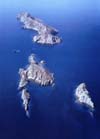Depleted cores found at SU002 and a large flint nodule from SU027 raise the issue regarding sources for the lithic materials. Although source material has yet to be located on Susac, it is interesting to note some lithic samples from both SU002 and SU027 resemble the general physical descriptions of the cherts from a nodular and tabular flint source recently confirmed on Palagruza (figure 8).
Furthermore, the presence of an Early Neolithic site on Palagruza
(Forenbaher et al. 1994; Kaiser and Kirigin 1994; Forenbaher and Kaiser 1997; Kaiser and Forenbaher 1999) in conjunction with the source materials (cf. Marchesetti 1876; Burton 1879) indicates a possible supply for the Susac materials.
However, and even more interesting when investigating long distance exchange networks, a Gargano (and thus Italian) provenance of a larger part of the lithic material including the nodule from SU027 has recently been suggested by petrographical micro-facies analysis (Jehanne Affolter, University of Neuchatel). Furthermore, Robert Tykot's analysis of obsidian fragments from SU027 indicates a Liparian origin of all the pieces sampled so far (figure 9).
The presence of sickle blades in a remote insular context is intriguing. Glossed sickle blades are known from the Early Neolithic site at Prato Don Michele (Tine's Phase I, Mueller's Impresso A) on the Tremiti Islands (see Whitehouse 1987). However, the Tremiti site is described as a settlement and at this stage, there is little evidence to support a similar occupation on Susac. Therefore, if Susac was visited for the purpose of harvesting wild flora and fauna, then an alternative picture of maritime exploitations may be drawn.
The situation obviously changed in the Middle Neolithic, with domesticated animals being introduced to structured settlements on the island, while there is still ample evidence for the exploitation of maritime resources.
The pottery from the Early Neolithic sites is confined to the "A" phase of the Early Neolithic chronology. Generally, Dalmatian sites with corresponding pottery indicate a generous ca. 5500-6500 Cal BC time range. However, sites closer to Susac, such as Vela Spilja on Korcula or Gudnja pecina on the Peljesac Peninsula, fall within the 6000-6500 Cal BC range (Chapman 1988; Chapman and Mueller 1990, for uncalibrated dates and available laboratory numbers). This implies that sites closer to the "island bridge" (figure 10) linking the opposing Adriatic shores exhibit earlier dates. Obviously this requires further substantiation.
The
concept of an "island bridge" is not new to the literature, but the
evidence from Susac, in conjunction with Vis and Palagruza, now
confirms deep-water ventures into the Adriatic during the Early and
Middle Neolithic. It is now possible to incorporate evidence from the
"island bridge" into a broader archaeological and historical framework
(Kaiser and Forenbaher 1999; Bass 1998).


